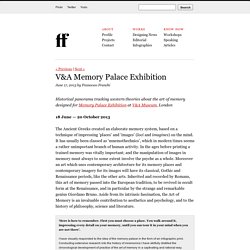

Naperville Public Library /All Locations. How to Build a Memory Palace (with Sample) <img alt="Image titled Build a Memory Palace Step 1" src=" width="728" height="546" class="whcdn">1Edit step1Decide on a blueprint for your palace.

While a memory palace can be a purely imagined place, it is easier to base it upon a place that exists in the real world and that you are familiar with or you can use some places of your favorite video game. A basic palace could be your bedroom, for example. Larger memory palaces can be based on your house, a cathedral, a walk to the corner store, or your town. The larger or more detailed the real place, the more information you can store in the corresponding mental space. <img alt="Image titled Build a Memory Palace Step 2" src=" width="728" height="546" class="whcdn">2Edit step2Define a route.
Francesco Franchi – V&A Memory Palace Exhibition. Historical panorama tracking western theories about the art of memory designed for Memory Palace Exhibition at V&A Museum, London 18 June — 20 October 2013 The Ancient Greeks created an elaborate memory system, based on a technique of impressing ‘places’ and ‘images’ (loci and imagines) on the mind.

It has usually been classed as ‘mnemothechnics’, which in modern times seems a rather unimportant branch of human activity. In the ages before printing a trained memory was vitally important; and the manipulation of images in memory must always to some extent involve the psyche as a whole. Moreover an art which uses contemporary architecture for its memory places and contemporary imagery for its images will have its classical, Gothic and Renaissance periods, like the other arts.
I have visually responded to the idea of the memory palace in the form of an infographic print. . © Francesco Franchi, 2013 Installation images at the V&A © Victoria and Albert Museum, London. Method of loci. The method of loci (loci being Latin for "places") is a method of memory enhancement which uses visualizations with the use of spatial memory, familiar information about one's environment, to quickly and efficiently recall information.

The method of loci is also known as the memory journey, memory palace, or mind palace technique. This method is a mnemonic device adopted in ancient Roman and Greek rhetorical treatises (in the anonymous Rhetorica ad Herennium, Cicero's De Oratore, and Quintilian's Institutio Oratoria). Many memory contest champions claim to use this technique to recall faces, digits, and lists of words. These champions' successes have little to do with brain structure or intelligence, but more to do with using spatial memory[1] and the use of the method of loci. 'the method of loci', an imaginal technique known to the ancient Greeks and Romans and described by Yates (1966) in her book The Art of Memory as well as by Luria (1969).
Contemporary usage[edit] Literature[edit] Memories are made of this: how to boost your mind. Just inside the front door of my childhood home I have, I tell author Joshua Foer, placed a glitter-covered eyeball with cartoon legs and a long grey beard.

He thinks for a moment before replying. "Is the long grey beard coming out of the thigh? That would make a lot more sense. " He is right. Today, Foer is tutoring me in how to remember poetry, and the sparkling eye-beard monster is my mental cue for the line "By thy long grey beard and glittering eye". "The whole art of this sport," explains Foer, wrapping the word sport in qualifying air quotes, "is in transforming information that's unmemorable into imagery that's so weird and raunchy and smelly and emotionally resonant that you can't forget it. " Our goal today is to commit to memory at least the first part of Coleridge's Rime of the Ancient Mariner. Foer's book Moonwalking with Einstein documents his transformation from forgetful young science journalist to US national memory champion. It is an art that is easily learned.
Hold off!